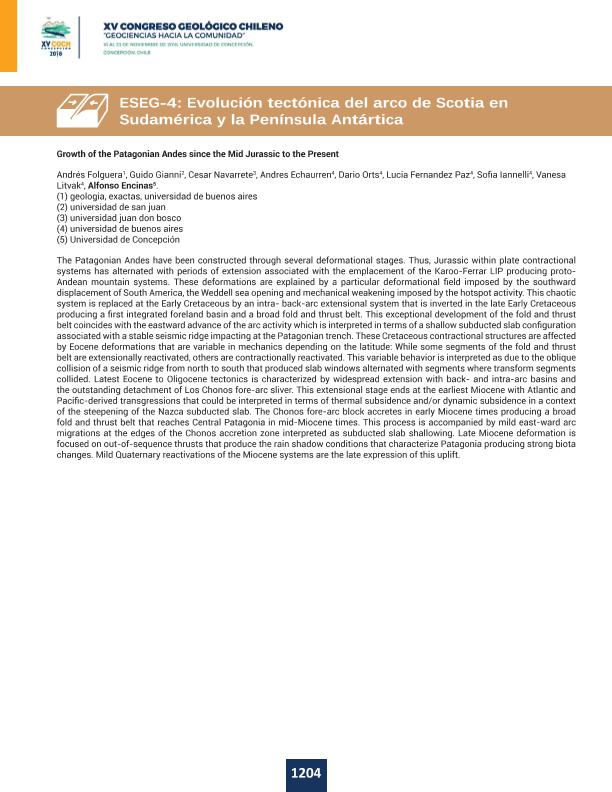Evento
Growth of the Patagonian Andes since the Mid Jurassic to the Present
Folguera Telichevsky, Andres ; Gianni, Guido Martin
; Gianni, Guido Martin ; Navarrete, Cesar; Echaurren Gonzalez, Andres
; Navarrete, Cesar; Echaurren Gonzalez, Andres ; Orts, Darío Leandro
; Orts, Darío Leandro ; Fernández Paz, Lucía
; Fernández Paz, Lucía ; Iannelli, Sofía
; Iannelli, Sofía ; Litvak, Vanesa Dafne
; Litvak, Vanesa Dafne ; Encinas, Alfonso
; Encinas, Alfonso
 ; Gianni, Guido Martin
; Gianni, Guido Martin ; Navarrete, Cesar; Echaurren Gonzalez, Andres
; Navarrete, Cesar; Echaurren Gonzalez, Andres ; Orts, Darío Leandro
; Orts, Darío Leandro ; Fernández Paz, Lucía
; Fernández Paz, Lucía ; Iannelli, Sofía
; Iannelli, Sofía ; Litvak, Vanesa Dafne
; Litvak, Vanesa Dafne ; Encinas, Alfonso
; Encinas, Alfonso
Tipo del evento:
Congreso
Nombre del evento:
XV Congreso Geológico Chileno
Fecha del evento:
11/2018
Institución Organizadora:
Universidad de Concepción;
Colegio de Geólogos de Chile;
Sociedad Geológica de Chile;
Título del Libro:
Actas del XV Congreso Geológico Chileno
Editorial:
Universidad de Concepción
Idioma:
Inglés
Clasificación temática:
Resumen
The Patagonian Andes have been constructed through several deformational stages. Thus, Jurassic within plate contractional systems has alternated with periods of extension associated with the emplacement of the Karoo-Ferrar LIP producing proto- Andean mountain systems. These deformations are explained by a particular deformational field imposed by the southward displacement of South America, the Weddell sea opening and mechanical weakening imposed by the hotspot activity. This chaotic system is replaced at the Early Cretaceous by an intra- back-arc extensional system that is inverted in the late Early Cretaceous producing a first integrated foreland basin and a broad fold and thrust belt. This exceptional development of the fold and thrust belt coincides with the eastward advance of the arc activity which is interpreted in terms of a shallow subducted slab configuration associated with a stable seismic ridge impacting at the Patagonian trench. These Cretaceous contractional structures are affected by Eocene deformations that are variable in mechanics depending on the latitude: While some segments of the fold and thrust belt are extensionally reactivated, others are contractionally reactivated. This variable behavior is interpreted as due to the oblique collision of a seismic ridge from north to south that produced slab windows alternated with segments where transform segments collided. Latest Eocene to Oligocene tectonics is characterized by widespread extension with back- and intra-arc basins and the outstanding detachment of Los Chonos fore-arc sliver. This extensional stage ends at the earliest Miocene with Atlantic and Pacific-derived transgressions that could be interpreted in terms of thermal subsidence and/or dynamic subsidence in a context of the steepening of the Nazca subducted slab. The Chonos fore-arc block accretes in early Miocene times producing a broad fold and thrust belt that reaches Central Patagonia in mid-Miocene times. This process is accompanied by mild east-ward arc migrations at the edges of the Chonos accretion zone interpreted as subducted slab shallowing. Late Miocene deformation is focused on out-of-sequence thrusts that produce the rain shadow conditions that characterize Patagonia producing strong biota changes. Mild Quaternary reactivations of the Miocene systems are the late expression of this uplift.
Palabras clave:
Andes
,
structure
,
uplift
,
basin
Archivos asociados
Licencia
Identificadores
Colecciones
Eventos(IDEAN)
Eventos de INSTITUTO DE ESTUDIOS ANDINOS "DON PABLO GROEBER"
Eventos de INSTITUTO DE ESTUDIOS ANDINOS "DON PABLO GROEBER"
Eventos(IIPG)
Eventos de INSTITUTO DE INVESTIGACION EN PALEOBIOLOGIA Y GEOLOGIA
Eventos de INSTITUTO DE INVESTIGACION EN PALEOBIOLOGIA Y GEOLOGIA
Citación
Growth of the Patagonian Andes since the Mid Jurassic to the Present; XV Congreso Geológico Chileno; Concepción; Chile; 2018; 1-1
Compartir



